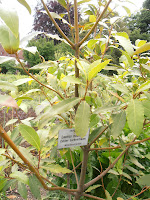 The sky continued to darken as we passed the oblong pools with a wide variety of outdoor aquatic plants. I'm sure the colors would have been much more vibrant under a blue sky and the clouds would have reflected beautifully in the still waters.
The sky continued to darken as we passed the oblong pools with a wide variety of outdoor aquatic plants. I'm sure the colors would have been much more vibrant under a blue sky and the clouds would have reflected beautifully in the still waters. |
Just before we went through the gate into the herb garden, Dr. Schnaubelt pointed out a Gallica rose (Rosa gallica), the predecessor to modern roses. It is apparently one of the earliest species to be cultivated by the Greeks and Romans; most contemporary European roses have at least a small contribution from this cultivar in their ancestry.
 |
| Pink Rosa gallica |
Continuing on towards the rear of the property, we came upon the herb garden, including an extensive area of herbs, trees, and bushes that produce essential oils (Atherische ole). Of course, that was our main area of interest so we spent a lot of time there examining the foliage and taking tons of pictures.
 Below are two types of Echinacea purpura, white and pink.
Below are two types of Echinacea purpura, white and pink.
We saw several more members of the Asteracea family: Feverfew and German chamomile, or Matricaria recutita. I took a photo of the chamomile in with the poppy because I liked the combination of the red with the delicate white and yellow.
 | |
| Feverfew. |
 |
| German chamomile. |
 |
| Nice combo. |
Here's what the flower of the Valerian plant looks like. (Later, I recognized several Valerian plants growing wild in the ditch at Bernard Nusstein's farm.) Of course, it didn't smell like Valerian since the oil is obtained from the roots.
I don't remember what this plant is but the bee sure liked it!
I thought these were pretty interesting looking:
And of course, we all recognize Lavender, Lavandula angustifolia. These are obviously planted from seed as the colors are so different.This is referred to as "population lavender". (Clones, by definition, will be all one color as the off-spring are taken from cuttings of the mother plant.)
 |
| Population Lavender (Lavandula angustifolia grown from seed). |
The plant below, Monarda, is also known as Bee Balm. Little did I know when I took this picture that this unassuming herb would be the star of the show during our distillation demonstration at the Technical University of Munich.
 |
| Monarda fistulosa. |
In researching Monarda, I found out that Monarda fistulosa typically has a purple colored flower. Monarda didyma has a reddish blossom in the same shape as fustulosa but a different color. The native Americans used to make a tea of it called Oswego tea and this is the variety that is often called Bergamot mint. The natives in the New World taught the newly arrived English folks how to make tea from the Monarda plants after they refused to drink English tea (the original tea party in Boston harbor).
The following Thyme plant, Thymus serpilum, is supposed to be an old form of thyme from which our modern varieties descend:
 |
| Thymus serpilum |
 |
| Laurus nobilis |
We ate a light lunch in the glassed-in terrace of the "Palmenhaus", then proceeded to the back of the property and through a gate to the grounds of the Nymphenberg Palace.
Check out the next blog post for more details about the amazing complex of buildings that make up the Nymphenburg Palace Park.
(We dubbed this tree on the palace grounds The Love Tree because of the heart on the branch at the top left. Someone from our group suggested that Gudrun and Georg hold hands around The Love Tree. Cute...)






No comments:
Post a Comment